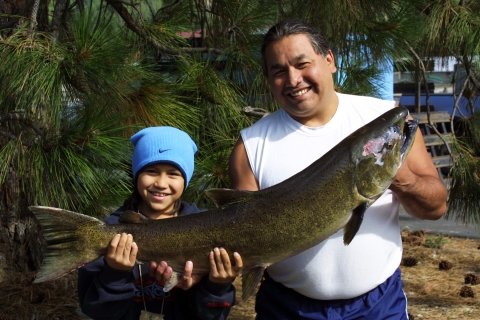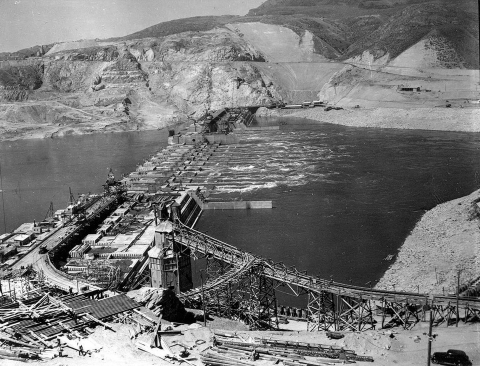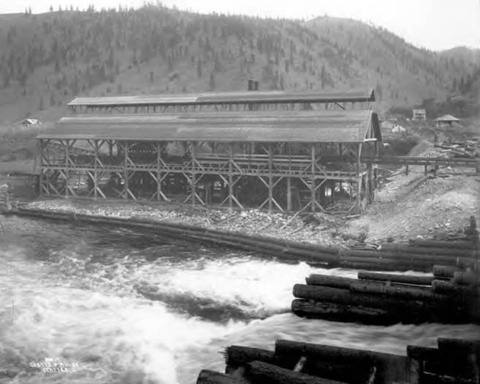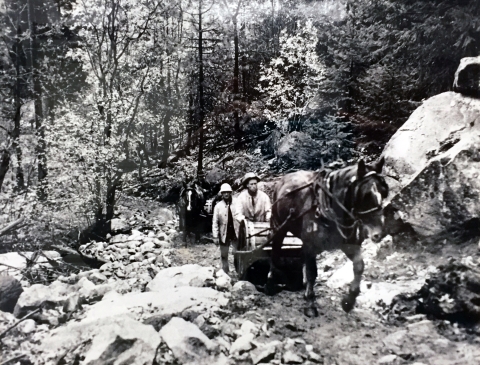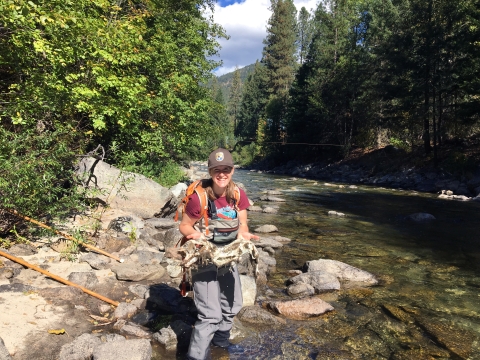What We Do
Since hatchery fish production began in 1940, Leavenworth National Fish Hatchery has produced several trout and salmon species including, spring and summer Chinook, sockeye, coho and steelhead/rainbow trout. Beginning in the early 1970’s other species were phased out and spring Chinook became the primary species produced at the hatchery. In 2001 a coho program was brought to our hatchery through a partnership with Yakama Nation Fisheries.
Today the hatchery releases over 1.2 million juvenile spring Chinook salmon and 500 thousand juvenile coho salmon into Icicle Creek annually. An additional 500 thousand coho salmon eggs are fertilized and incubated on site, before they are transferred to other hatcheries.
During their out-migration, years in the ocean, and returning migration, these salmon provide food to predators that historically would have relied on salmon that were spawned in the Columbia River Basin above Grand Coulee Dam. Additionally, they provide catch for commercial fisheries in the ocean and commercial, tribal, and sport anglers in the lower Columbia River every year. When enough adults return, our salmon supply the sport and tribal salmon fisheries on Icicle Creek in June-July and October-November.
The next time you go fishing, you might just catch a salmon that was raised at Leavenworth National Fish Hatchery. Since 1871, National Fish Hatcheries have been responding to conservation challenges affecting America’s fish and other aquatic species. Producing fish continues to be an irreplaceable tool in managing or restoring fisheries along with habitat conservation. In doing so, we help provide recreation opportunities to America’s 34 million anglers who spend $36 billion annually in pursuit of their favored pastime.
Juvenile spring Chinook salmon from our hatchery are released into Icicle Creek. These smolts migrate 500 miles downstream through the Wenatchee River and the Columbia River to make it to the Pacific Ocean. After feeding in the ocean for one to three years, they retrace their path and return to the hatchery where they were born, ready to spawn. Along the way these salmon provide food for other wildlife in rivers and the ocean, valuable catch for commercial fishing vessels, and harvest for sport and tribal anglers.
Management and Conservation
Leavenworth Fisheries Complex has been in service since 1940. The history of the Complex is linked to the history of Grand Coulee Dam.
Construction of Grand Coulee Dam provided irrigation water to two million acres of farmland in Washington State, but at a tremendous cost: the upper river is completely blocked to the movement of fish. Four hatcheries were planned to mitigate for that impact under the Grand Coulee Fish Maintenance Project, and construction was completed on the first one at Leavenworth in 1940, at Entiat in 1941, and at Winthrop in 1942. Chief Joseph Hatchery, managed by the Confederated Tribes of the Colville, was completed in 2013.
Salmon and steelhead in these hatcheries are raised for release into the Wenatchee, Entiat, Methow, and Okanogan rivers, boosting wild populations or re-introducing new ones. Monitoring, started in 1939, is part of the work to evaluate the impacts and effectiveness of mitigation. The Mid-Columbia Fish & Wildlife Conservation Office joined the Complex in 1978 to continue carrying out the monitoring and evaluation.
Grand Coulee Dam was not the first thing to impact fish in the Columbia River Basin. Power dams, mill dams, unscreened irrigation canals, and heavy water use had decimated salmon runs by 1939. Under the project, salmon and steelhead were trapped at Rock Island Dam from 1939-1943 and transplanted to bring back natural populations. Spring and summer Chinook salmon and steelhead were placed in the Wenatchee and Entiat rivers and in Nason Creek. Sockeye salmon were moved to Lake Wenatchee and Lake Osoyoos.
Siting and building the hatcheries was based on where good water was available. At Leavenworth, for example, crews forged a trail up into the nearby mountains, creating a route that would later become a popular access to what is today the Alpine Lakes Wilderness. The trail led to Snow and Nada lakes, which were dammed to trap snowmelt in summer. Engineers from the Bureau of Reclamation blasted through 2,500 feet of solid granite, forming a tunnel to draw water from the lakes through a valve. To this day, that alpine water still feeds into Icicle Creek when hatchery workers open the valve in summer, bringing critical cool water to fish habitat and hatchery salmon.
Spawning ground surveys began in 1939 to see if reintroductions were working. These surveys continue today throughout all potential spawning habitat. Hatchery impact was measured beginning in 1940 by checking fish origins, and also continues now. The conservation office’s Hatchery Evaluation Program works closely with the hatcheries in our complex, providing data that help managers hone their methods, meet program goals, and avoid harm to native fish populations.
Many decades have passed, and the success of the Grand Coulee Fish Maintenance Project can be measured by the runs of salmon still returning and the dedicated efforts of our staff and our many partners.
Our Services
You'll find useful data in this section.
Spring Chinook salmon returns:
- 2024: 3,500 spring Chinook returned to Leavenworth NFH
- 2023: 6,267 spring Chinook returned to Leavenworth NFH
- 2022: 10,839 spring Chinook returned to Leavenworth NFH
- 2021: 4,566 spring Chinook returned to Leavenworth NFH
- 2020: 2,262 spring Chinook returned to Leavenworth NFH
- 2019: 1,470 spring Chinook returned to Leavenworth NFH
- 2018: 976 spring Chinook returned to Leavenworth NFH
Track our salmon as they return via the Fish Passage Center's website.
Weather data is collected daily at the hatchery. Data are displayed on the National Oceanic and Atmospheric Administration's website.
Our Projects and Research
National Fish Hatcheries raise fish and other aquatic species to help restore and sustain important wildlife populations for the benefit of the American people. Salmon play very important roles in our rivers and oceans by providing essential food for other fish, birds, and mammals, and transporting nutrients from oceans to freshwater rivers and streams. With declining fish populations becoming prevalent across the northwest, fish hatchery operations are more important than ever.
Leavenworth National Fish Hatchery works with partners to find innovative solutions to problems like water use. Salmon and other wild fish must have clean, cool water. So must hatcheries. Water is also in high demand for irrigation, businesses, and homes in our growing communities. We look for ways to reduce our impact, like updating equipment and facilities to run more efficiently, or switching to recirculating aquaculture systems. Learn more about our pilot partial re-use aquaculture system (pRAS) via video.


